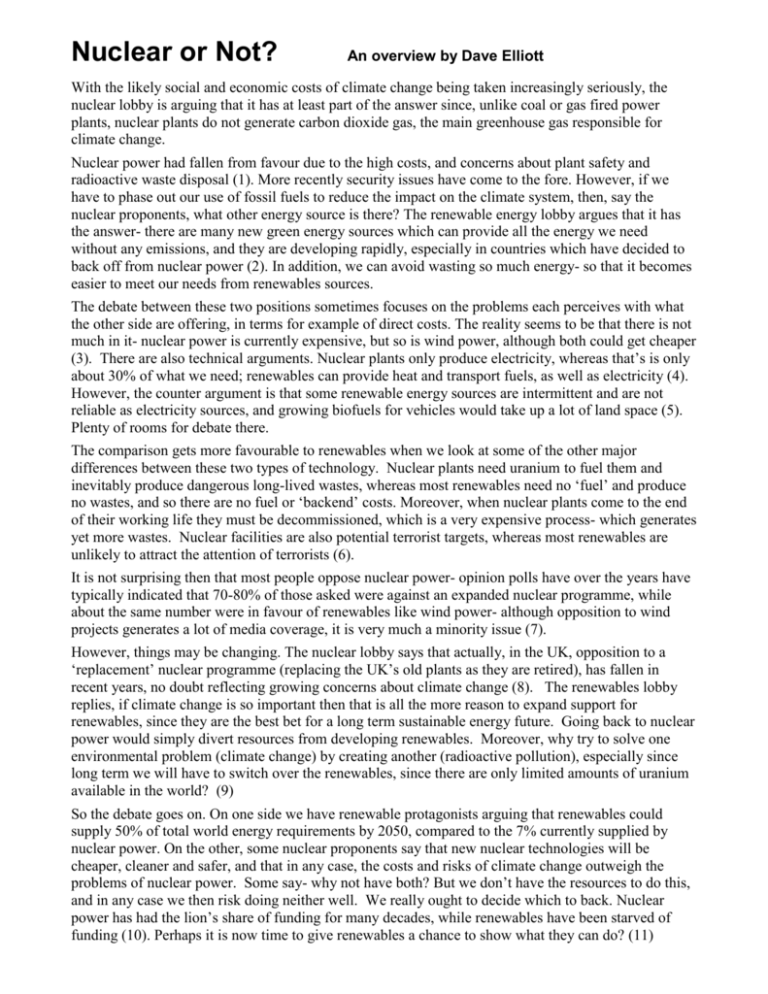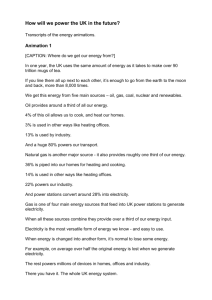Professor David Elliott Op-Ed article
advertisement

Nuclear or Not? An overview by Dave Elliott With the likely social and economic costs of climate change being taken increasingly seriously, the nuclear lobby is arguing that it has at least part of the answer since, unlike coal or gas fired power plants, nuclear plants do not generate carbon dioxide gas, the main greenhouse gas responsible for climate change. Nuclear power had fallen from favour due to the high costs, and concerns about plant safety and radioactive waste disposal (1). More recently security issues have come to the fore. However, if we have to phase out our use of fossil fuels to reduce the impact on the climate system, then, say the nuclear proponents, what other energy source is there? The renewable energy lobby argues that it has the answer- there are many new green energy sources which can provide all the energy we need without any emissions, and they are developing rapidly, especially in countries which have decided to back off from nuclear power (2). In addition, we can avoid wasting so much energy- so that it becomes easier to meet our needs from renewables sources. The debate between these two positions sometimes focuses on the problems each perceives with what the other side are offering, in terms for example of direct costs. The reality seems to be that there is not much in it- nuclear power is currently expensive, but so is wind power, although both could get cheaper (3). There are also technical arguments. Nuclear plants only produce electricity, whereas that’s is only about 30% of what we need; renewables can provide heat and transport fuels, as well as electricity (4). However, the counter argument is that some renewable energy sources are intermittent and are not reliable as electricity sources, and growing biofuels for vehicles would take up a lot of land space (5). Plenty of rooms for debate there. The comparison gets more favourable to renewables when we look at some of the other major differences between these two types of technology. Nuclear plants need uranium to fuel them and inevitably produce dangerous long-lived wastes, whereas most renewables need no ‘fuel’ and produce no wastes, and so there are no fuel or ‘backend’ costs. Moreover, when nuclear plants come to the end of their working life they must be decommissioned, which is a very expensive process- which generates yet more wastes. Nuclear facilities are also potential terrorist targets, whereas most renewables are unlikely to attract the attention of terrorists (6). It is not surprising then that most people oppose nuclear power- opinion polls have over the years have typically indicated that 70-80% of those asked were against an expanded nuclear programme, while about the same number were in favour of renewables like wind power- although opposition to wind projects generates a lot of media coverage, it is very much a minority issue (7). However, things may be changing. The nuclear lobby says that actually, in the UK, opposition to a ‘replacement’ nuclear programme (replacing the UK’s old plants as they are retired), has fallen in recent years, no doubt reflecting growing concerns about climate change (8). The renewables lobby replies, if climate change is so important then that is all the more reason to expand support for renewables, since they are the best bet for a long term sustainable energy future. Going back to nuclear power would simply divert resources from developing renewables. Moreover, why try to solve one environmental problem (climate change) by creating another (radioactive pollution), especially since long term we will have to switch over the renewables, since there are only limited amounts of uranium available in the world? (9) So the debate goes on. On one side we have renewable protagonists arguing that renewables could supply 50% of total world energy requirements by 2050, compared to the 7% currently supplied by nuclear power. On the other, some nuclear proponents say that new nuclear technologies will be cheaper, cleaner and safer, and that in any case, the costs and risks of climate change outweigh the problems of nuclear power. Some say- why not have both? But we don’t have the resources to do this, and in any case we then risk doing neither well. We really ought to decide which to back. Nuclear power has had the lion’s share of funding for many decades, while renewables have been starved of funding (10). Perhaps it is now time to give renewables a chance to show what they can do? (11) Notes (1) No new nuclear plants have been ordered in the USA since the Three Mile Island accident in 1979 and following the Chernobyl accident in 1986, most of the EU decided to phase out nuclear power. Globally over 30 gigawatts of nuclear plant has been closed or retired, although China and India are still expanding their nuclear programmes (2) Denmark gets over 20% of its annual electricity requirements from wind turbines. Germany has installed over 16 gigawatts of wind generation capacity. So far there is around 42 gigawatts of wind capacity in use in the world and around 70 GW (thermal) of solar energy conversion capacity. (3) The 2002 Cabinet Office ‘Energy Review’ estimated that by 2020 on shore wind would the cheapest energy option at 1-5-2.5 pence per kilowatt hour (the current average price is around 3p/kWh), while offshore wind farms might generate power at between 2-3p/kWh. It suggested that new nuclear plants might generate at between 3-5 p/kWh, but the nuclear industry claims that it can get it down to 2.5p/kWh. (4) Electricity from nuclear plants could be used for electric vehicles and also for producing hydrogen gas to power vehicles. But that is also true of electricity from renewables. In theory, waste heat from nuclear plants could be used in district heating networks, but that would imply that the nuclear plants had to be in or near inner city areas, and so far all the UK’s nuclear plants have been put in remote areas on safety grounds, usually by the coast to get access to cooling water. That actually may prove to be a problem in future, given the risk of sea level rises as a result of climate change. However, locating nuclear plants in-land may also be a problem since water is likely to become an increasingly scarce resource due the climate change. That of course could also effect the viability of biofuel and energy-crop production. (5) The intermittency of some renewable sources like wind is not a major problem. The existing power system already has to cope with sudden large variations in power supply inputs when conventional power stations unexpectedly go off-line. As long as the total contribution from intermittent sources is less than about 20%, the smaller variations in input from these sources is in effect balanced out by the national grid system. Above a 20% contribution then we may need more backup plants and energy storage systems, but by that time we could be using renewables to generate hydrogen gas, as a new energy medium, and that is storable. (6) Over the next century the UK will have to deal with 500,000 tonnes of nuclear waste of various types as existing plants are closed and decommissioned. The total nuclear liability has been put at £48billion. BNFL currently spends £50m pa on security e.g. armed police to protect against terrorists (7) An opinion Poll for the Royal Society for the Protection of Birds found that only 3% of their sample opposed wind farms. In the 'worst case' poll, in Wales, objectors were14%. (8) A Mori poll in 2001 found that 19% favoured a replacement programme, while 57% opposed it. By 2004 the figures had changed to 30% for and 34% against. (9) Reserves depend on the price that is acceptable and the rate of use. In 1990 the UK Atomic Energy Authority said that, using conventional thermal/ burner reactors, ‘ for a nuclear programme that expands continuously to about 50% of [electricity] demand, uranium resources are only adequate for about 45years’. Uranium finds since then may have increased the resource, but a major nuclear programme would lead to lower grade ores being used, which would require more energy for fuel production and lead to more carbon dioxide emissions. (10) UK Government funding for nuclear research and development ran at around £200m through most of the 1970’s, whereas spending on R&D for renewables only rose gradually to about 10% of that before being cut back under the Thatcher government. Renewables still only get around £20m p.a. for R&D, while nuclear power gets around £60m p.a. (excluding the liabilities). However, a new renewables grant scheme is now offering more to help new projects get going, including grants for offshore wind, wave and tidal current projects. (11) The governments 2004 White paper on energy saw renewables and energy efficiency as the main way ahead but said that nuclear power should be kept open as an option for the longer term in case renewables and efficiency did not deliver as hoped. More recently interest has also been shown in undersea carbon sequestration (storage in old oil and gas wells) as a way to allow us to continue to use fossil fuels for a while, without having an impact on the climate. Prof. David Elliott, EERU, Open University March 2005






